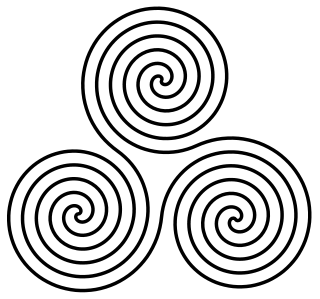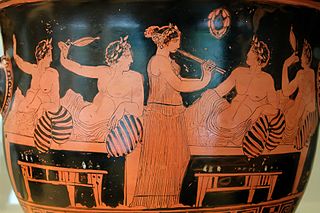Reference
- Walters, Henry Beauchamp, History of Ancient Pottery, Greek, Etruscan, and Roman, Based on the Work of Samuel Birch, Volume 2, London, J. Murray, 1905.
In Greek mythology, Tara was one of the seven Hesperides and sister of Aiopis, Antheia, Kalypso, Donakis, Mermesa and Nelisa. [1]
In Greek mythology, Chrysothemis or Khrysothemis is a name ascribed to several characters.
In Greek mythology, Lilaea or Lilaia may refer to two different women:

A triskelion or triskeles is an ancient motif consisting of a triple spiral exhibiting rotational symmetry. The spiral design can be based on interlocking Archimedean spirals, or represent three bent human legs.

In ancient Greece, the symposium was a part of a banquet that took place after the meal, when drinking for pleasure was accompanied by music, dancing, recitals, or conversation. Literary works that describe or take place at a symposium include two Socratic dialogues, Plato's Symposium and Xenophon's Symposium, as well as a number of Greek poems such as the elegies of Theognis of Megara. Symposia are depicted in Greek and Etruscan art that shows similar scenes.

Etruscan art was produced by the Etruscan civilization in central Italy between the 10th and 1st centuries BC. From around 750 BC it was heavily influenced by Greek art, which was imported by the Etruscans, but always retained distinct characteristics. Particularly strong in this tradition were figurative sculpture in terracotta, wall-painting and metalworking especially in bronze. Jewellery and engraved gems of high quality were produced.
In Greek mythology, Calyce or Calycia is the name of several characters.
Anakles was a 6th-century B.C. Greek vase-painter whose work was closely associated with that of Nikosthenes with whom he may have been in partnership.
Galene in ancient Greek religion was a minor goddess personifying calm seas. Hesiod enumerates her as one of the 50 Nereids, sea-nymph daughters of the 'Old Man of the Sea' Nereus and the Oceanid Doris, perhaps identical with her sister Galatea.

Asterope was a Hesperid in Greek mythology.
In Greek mythology, Asterope may refer to the following characters:
In Greek mythology, Chryseis may refer to the following women:
In Greek mythology, Pericylmene or Periklymene may refer to two distinct characters:
In Greek mythology, Calypso is the name of several nymphs, the most well known being:
In Greek mythology, Lipara was one of the Hesperides and sister to Asterope, Chrysothemis, Hygieia.
In Greek mythology, Xanthe or Xantho may refer to the following divinity and women:
In Greek mythology, Cissus or Cissos was a satyr who was turned into an ivy plant.
In Greek mythology, Aiopis was one of the seven Hesperides and sister of Antheia, Kalypso, Donakis, Mermesa, Nelisa and Tara.
In Greek mythology, Donakis was one of the seven Hesperides and sister of Aiopis, Antheia, Kalypso, Mermesa, Nelisa and Tara.
In Greek mythology, Mermesa was one of the seven Hesperides and sister of Aiopis, Antheia, Donakis, Kalypso, Nelisa and Tara.
In Greek mythology, Nelisa was one of the seven Hesperides and sister of Aiopis, Antheia, Donakis, Kalypso, Mermesa and Tara.